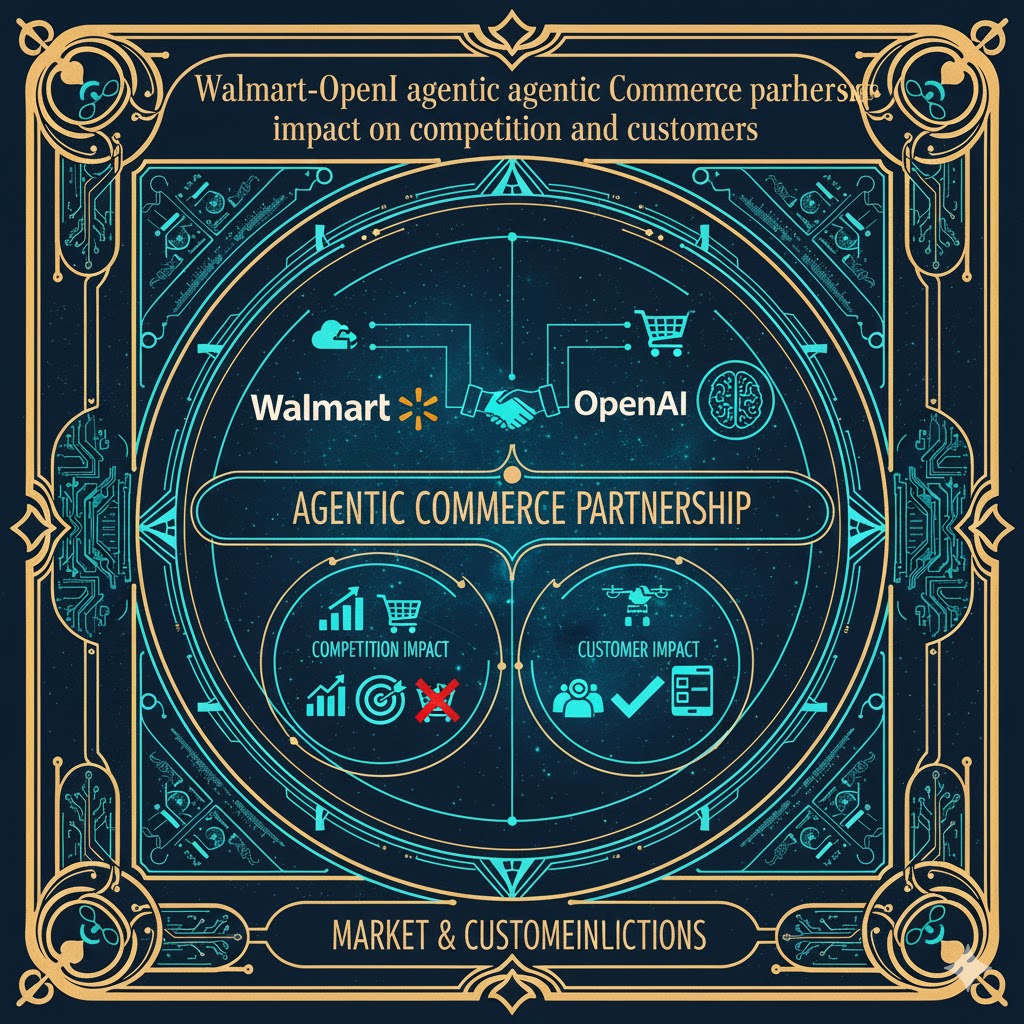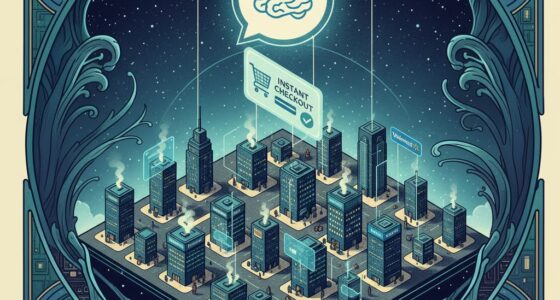Introduction
On 14 October 2025 Walmart announced a strategic partnership with OpenAI to allow customers and Sam’s Club members to shop directly inside ChatGPT using a feature called Instant Checkoutcorporate.walmart.com. Instead of typing keywords into a search bar and clicking through long lists of product pages, shoppers will be able to converse with the chatbot, receive curated product recommendations and complete their purchase without leaving the chat. Walmart sees this as the start of an AI‑first, agentic commerce era where artificial‑intelligence “agents” learn, plan and predict customers’ needs and proactively help them shopcorporate.walmart.com. The company’s CEO Doug McMillon described the experience as multi‑media, personalized and contextual, a shift “beyond the search bar”corporate.walmart.com.
The partnership signals a pivotal moment for retail and raises important questions for competitors, brands and consumers across key verticals. This article synthesizes the available facts and expert commentary to assess the impact on competition, customer experience and the broader commerce ecosystem.
How Instant Checkout works
The Agentic Commerce Protocol
Instant Checkout is built on the Agentic Commerce Protocol (ACP), an open standard developed by OpenAI and payment partner Stripe. When a shopper asks ChatGPT for a product recommendation (e.g., “best carry‑on bag under $300”), the model recommends items with images, pricing and details. If a listing is ACP‑enabled, the shopper can tap a Buy Now button and confirm shipping and payment details directly in the chat. The merchant continues to own fulfillment, refunds and customer service, while payment data are passed via encrypted tokensbebolddigital.com.
Initial rollout and product scope
- Single‑item purchases – The first version of Instant Checkout only supports single‑item transactionsretaildive.com. Multi‑item carts and a wider SKU catalog are on OpenAI’s roadmapfeedvisor.com.
- Categories included – Publicis Commerce noted that Walmart’s initial catalog for ChatGPT would include apparel, entertainment, packaged foods and other products from Walmart, Sam’s Club and third‑party marketplace sellersmarsunited.com. Fresh foods are excluded for now, reflecting cold‑chain complexities.
- Payment setup – Customers must add their payment method to ChatGPT to use Instant Checkout. A unique token is created allowing the AI agent to place orders on the customer’s behalf without re‑entering payment detailstalkbusiness.net. Visa and Mastercard models provide safeguards, but there are questions about who is responsible if the agent makes an unwanted purchasetalkbusiness.net.
- Merchant ranking and fees – ChatGPT considers whether a merchant has enabled Instant Checkout when ranking productsretaildive.com. Merchants pay a small fee per order; shoppers do notretaildive.com.
Impact on customers across key verticals
1. Grocery and meal planning
Opportunities. Grocery chatbots such as Instacart, Uber, Target and DoorDash are also integrating with ChatGPT to let users explore digital food aislesgrocerydive.com. In grocery, AI agents could help shoppers plan meals, substitute ingredients (e.g., suggesting a yogurt brand to replace eggs in a recipe) and recommend seasonal appetizersgrocerydive.com. Instant Checkout provides one‑tap purchases for pantry staples, making it useful for last‑minute restocking.
Challenges. The first version supports only single‑item purchasesretaildive.com, limiting utility for weekly grocery orders that typically involve dozens of items. Fresh foods are excludedmarsunited.com. Shoppers must trust the AI with payment data, and surveys cited by Visa show 67 % of consumers want human review for any transaction above a certain amount while 61 % desire real‑time spending notifications and a “panic button” to halt a purchasetalkbusiness.net. Thus the convenience of conversational grocery shopping may appeal to younger, low‑stakes buyers first, while adoption in higher‑value grocery baskets may lag.
2. Apparel, general merchandise and home goods
Walmart plans to make much of its 420 million‑plus SKU catalog available over timemarsunited.com. AI agents can surface clothing or home items based on style, size and budget described in natural language. This could benefit smaller brands whose products might otherwise be buried in traditional keyword search. Marketplace Pulse estimates that ChatGPT already handles 75.6 million product‑related conversations per week, and even a modest 2 % conversion could generate US$5.5 billion in annual gross merchandise valuemarketplacepulse.com. Early use cases may include single‑item apparel purchases, entertainment products or household essentials where frictionless reorder matters more than multi‑item complexity.
3. Consumer electronics and high‑consideration items
For expensive electronics or high‑consideration purchases, conversational commerce could provide richer education and comparisons. However, large‑basket purchases often rely on extended warranties, bundling and shipping logistics, which the first‑generation Instant Checkout does not yet address. Moreover, risk concerns intensify as order values rise; Visa’s survey shows consumers will demand human oversight for large purchases and may require features like spending limits or real‑time confirmationtalkbusiness.net. Retailers may have to offer additional assurance (e.g., easy returns, price matching) before customers trust an agent to buy an expensive laptop or appliance.
4. Digital goods and entertainment
Walmart’s catalog includes streaming subscriptions, ebooks and video games. ChatGPT can easily recommend and deliver digital goods because they do not require physical fulfilment. For example, a user asking for a family‑friendly movie for the weekend could receive a recommendation and purchase a rental instantly. Since digital goods often involve single items and lower risk, this vertical may see faster adoption.
Competitive dynamics
Amazon’s closed‑rail strategy vs. Walmart’s open‑rail strategy
While Walmart embraces an open‑rail approach—allowing products to be discovered and purchased inside ChatGPT—Amazon is taking the opposite path. The e‑commerce giant has blocked AI crawlers such as ChatGPT, Google and others from scraping its product data and is investing in its own assistant “Rufus”feedvisor.com. Amazon controls both discovery and checkout within its platform, ensuring that data and ad revenue stay inside its ecosystemfeedvisor.com. As a result, ChatGPT referral traffic to Amazon accounted for less than 3 % in August 2025, whereas ChatGPT drove 20 % of Walmart’s referral clicks, over 20 % to Etsy and nearly 15 % to Targetdigiday.com. By blocking external AI, Amazon protects its US$56 billion advertising businessdigiday.com.
However, Amazon’s defensive stance risks ceding surface area in conversational search to competitors. When AI tools cannot access Amazon’s 600 million product listings, they surface products from retailers like Walmart, which has 420 million SKUsdigiday.com. Feedvisor calls this emerging battle the “AI Storefront War”, where commerce splits into open conversational platforms like ChatGPT (supported by Walmart, Etsy and Shopify) and closed retail ecosystems like Amazon and Rufusfeedvisor.com. With 80 % of shoppers still beginning product searches on Amazonfeedvisor.com, the company retains huge leverage, but as conversational agents siphon off some search activity, brands may need to optimize their product data for both open and closed rails.
Retail media and advertising implications
Marketplace Pulse argues that Instant Checkout is a bigger threat to Amazon’s advertising business than its marketplace. ChatGPT processes 700 million weekly active users and an estimated 75.6 million shopping conversations per weekmarketplacepulse.com. If customers discover products organically through chat rather than paid ads on Amazon, sellers could avoid Amazon’s pay‑to‑play ad fees (US$56.2 billion in 2024)marketplacepulse.com. Conversational queries allow long, contextual descriptions, potentially surfacing niche products without keyword biddingmarketplacepulse.com. While initial GMV may be modest relative to Amazon’s US$600 billion third‑party marketplace, the shift threatens Amazon’s scarcity‑driven ad modelmarketplacepulse.com.
For Walmart, the risk is different. A Boston Consulting Group report cited by Talk Business warns that agentic commerce could reduce direct website traffic, undermining retail media revenue (Walmart’s media business earned about US$4.4 billion last year) and diminish cross‑selling opportunities because AI agents simplify purchases to single itemstalkbusiness.net. Reduced insight into customer behaviour could weaken personalization and data monetizationtalkbusiness.net. To remain visible in AI‑driven discovery, Walmart and brands will likely need to invest in AI‑optimized product feeds and advertising.
Other retailers and platforms
- Etsy and Shopify – The ChatGPT Instant Checkout feature debuted with Etsy and Shopify merchants in September 2025retaildive.com. This opened conversational commerce to over a million Shopify merchants and has already generated significant referral traffic to Etsydigiday.com.
- Target, Instacart, Uber and DoorDash – These companies plan to integrate with ChatGPT for grocery orderinggrocerydive.com, indicating that competition will extend beyond general merchandise to on‑demand delivery. Target is also reportedly working on its own AI agents.
- Payment and logistics players – Visa’s Michael Nevski noted that authentication and fraud prevention must evolve as AI agents make purchases without human promptstalkbusiness.net. McKinsey’s Marie‑Claude Nadeau suggests payments providers will move from stopping bots to enabling trusted agentstalkbusiness.net. Amazon is expanding its third‑party logistics to handle orders for Walmart, Shein and Shopify, so even if consumers buy via ChatGPT, Amazon could still earn delivery revenuemodernretail.co.
Risks and challenges
- User trust and control – Surveys found one‑third of consumers are unwilling to let AI agents make purchases, and two‑thirds would require human review for transactions beyond a certain amounttalkbusiness.net. People want panic buttons, spending notifications and spending capstalkbusiness.net. Without robust controls, unwanted or fraudulent orders could erode trust.
- Loss of direct customer relationship – Retailers may lose direct traffic to their websites as AI agents handle discovery and checkouttalkbusiness.net. Cross‑selling and upselling opportunities are reduced when purchases are single‑item. Retailers may need to invest more in AI advertising to maintain visibility within the chat environment.
- Bias and visibility – ChatGPT’s ranking algorithm favours merchants who enable Instant Checkoutretaildive.com. Smaller sellers might struggle if they cannot integrate with ACP or if they lack the data to feed the AI. The black‑box nature of AI means retailers cannot always tell why a competitor appears ahead in the resultsdigiday.com.
- Regulation and liability – Questions remain about who is liable when an AI agent orders the wrong product or misinterprets a customer’s intenttalkbusiness.net. The regulatory framework for autonomous agents is still evolving. Retailers and platforms will need to ensure compliance with consumer protection, data‑privacy and payment regulations.
Future outlook
The agentic commerce trend is expected to accelerate. McKinsey projects that AI shopping agents could orchestrate US$1 trillion in US B2C revenue by 2030 and US$3–5 trillion globallymckinsey.com. To compete, retailers must rethink their digital infrastructure, adopt standards such as ACP and upcoming Agent‑to‑Agent protocols, and re‑architect identity managementmckinsey.com. Business models will also change; success will depend on being discoverable to AI agents and optimizing product data and pricing for both open and closed platforms.
Competitors like Amazon will continue to invest in their own AI assistants and logistics to protect their walled gardens, while Walmart and others will expand their partnerships with OpenAI and similar platforms. For consumers, the near‑term benefits will be convenience in low‑stakes purchases and personalized recommendations, but trust and control features will be critical for adoption in high‑value categories. Brands and advertisers must prepare for a world where the buyer is often an AI agent, not a humantalkbusiness.net.
Conclusion
Walmart’s partnership with OpenAI marks the first step toward agentic commerce—an era where AI agents mediate shopping experiences from discovery to purchase. While the Instant Checkout feature currently supports only single‑item purchases, it signals a shift away from traditional e‑commerce flows. Customers stand to benefit from conversational convenience and personalized recommendations, especially in categories like grocery staples, apparel and digital goods. But there are significant risks around user trust, cross‑selling, data ownership and advertising revenue. Competitors such as Amazon are responding by fortifying their own ecosystems and investing in proprietary AI assistants. As the “AI Storefront War” unfolds, retailers, brands and consumers will need to navigate two rails—open conversational platforms and closed walled gardens—to remain visible and in control of the shopping journey.









